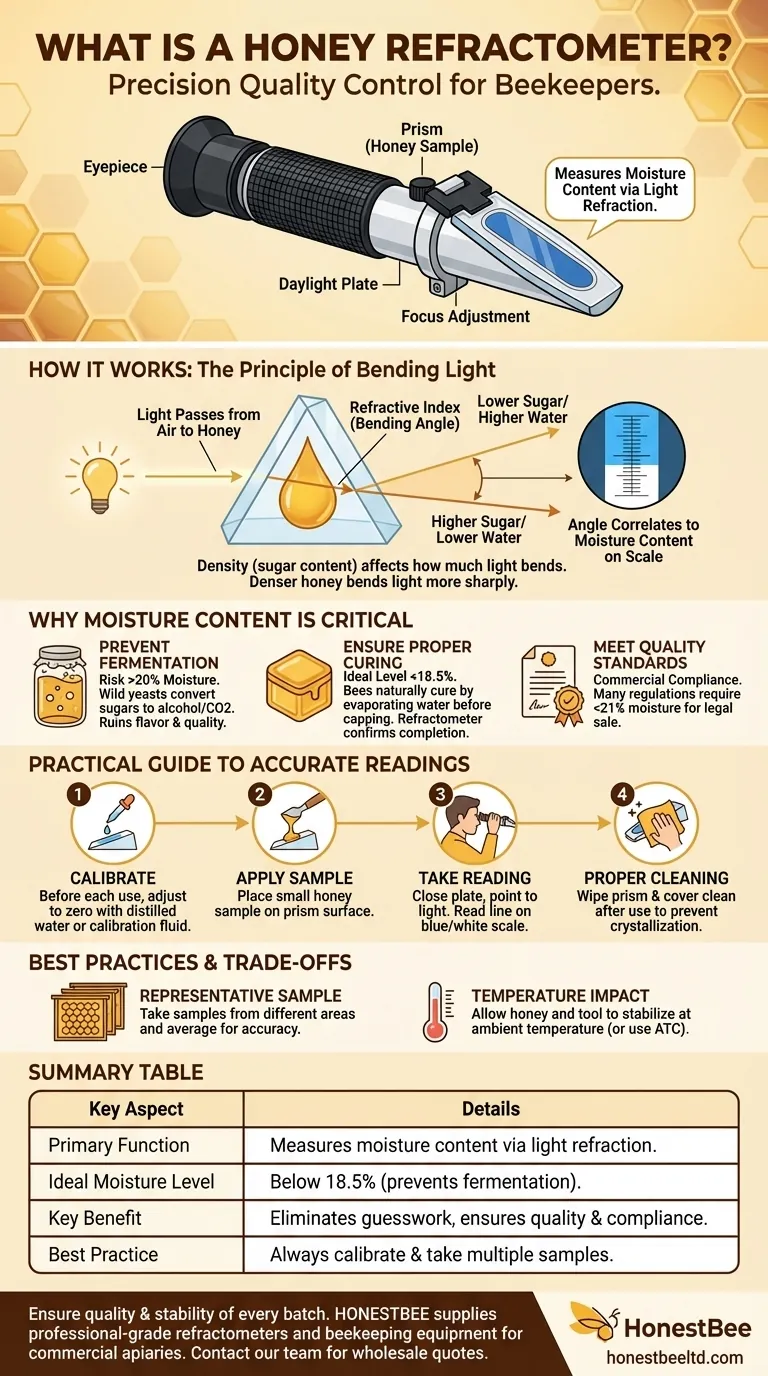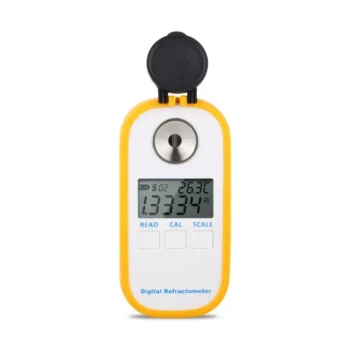A honey refractometer is a specialized optical instrument used by beekeepers to get a precise measurement of the moisture content in honey. It works by analyzing how light bends, or refracts, as it passes through a small honey sample. This simple, immediate test is the most reliable way to determine if honey is properly cured and ready for harvest, preventing spoilage and ensuring a high-quality, stable product.
The primary purpose of a honey refractometer is to eliminate guesswork. By providing a precise moisture percentage, it empowers beekeepers to harvest with confidence, ensuring the honey's long-term stability and preventing the fermentation that can ruin an entire batch.

The Principle Behind the Measurement: Bending Light
A refractometer operates on a fundamental property of physics known as light refraction. Understanding this simple principle clarifies exactly how the tool works.
The Role of Refractive Index
When light passes from one medium to another (like from air into honey), it changes speed and bends. The angle of this bend is called the refractive index.
How Solids Affect Light
The density of a liquid directly impacts its refractive index. Honey with a higher concentration of dissolved solids—primarily sugars—is denser. This density causes light to bend more sharply than it would in a liquid with a lower concentration of solids, such as water.
Translating Light into Data
The honey refractometer contains a prism and a calibrated scale. When you place honey on the prism, the device measures the angle at which light is refracted. It then automatically correlates that angle to a moisture content reading, giving you an immediate and accurate percentage.
Why Moisture Content is a Critical Quality Metric
Knowing the exact water percentage in your honey is not an academic exercise; it is the single most important factor in determining its quality and shelf-life.
Preventing Fermentation
Honey with a moisture content above approximately 20% is at high risk of fermentation. Wild yeasts naturally present in honey can become active in the excess water, converting sugars into alcohol and carbon dioxide. This spoils the flavor and can lead to the honey being downgraded to "baker's honey," which is unsuitable for direct consumption.
Ensuring Proper Curing
Bees naturally cure honey in the hive by fanning their wings over the honeycomb cells to evaporate water. When they cap a cell with wax, it is generally a sign that the honey is at the proper moisture level (typically below 18.5%). A refractometer provides definitive proof that this natural process is complete.
Meeting Quality and Legal Standards
For commercial sales, honey must often meet specific quality standards. For example, some regulations require moisture content to be below 21g per 100g. Using a refractometer ensures your product is compliant and maintains a reputation for high quality.
A Practical Guide to Accurate Readings
Using a refractometer is simple, but following a consistent process is essential for obtaining reliable data.
Step 1: Calibration is Non-Negotiable
Before each use, you must calibrate the device. This typically involves placing a drop of distilled water or a specific calibration fluid onto the prism and adjusting the scale to read zero. This ensures your baseline is accurate.
Step 2: Applying the Honey Sample
Using a clean hive tool, toothpick, or dropper, place a small amount of honey on the glass plate. You only need enough to cover the surface of the prism.
Step 3: Taking the Reading
Close the clear plate over the honey sample, which will spread the liquid evenly. Point the refractometer toward a natural light source and look through the eyepiece. The reading appears as a distinct line separating a blue and white field, indicating the moisture percentage on the scale.
Step 4: Proper Cleaning
After each use, wipe the prism and cover plate clean with a soft, damp cloth. Dried honey can crystallize on the surface and interfere with future readings.
Understanding the Trade-offs and Best Practices
While a refractometer is an invaluable tool, its accuracy depends on proper use and an understanding of its limitations.
The Need for a Representative Sample
A single reading from one honeycomb cell may not represent the entire frame or hive. For the most accurate assessment, it is best to take samples from several different areas of a frame and average the results.
The Impact of Temperature
Extreme temperatures can slightly affect the refractive index of honey. Most modern refractometers have Automatic Temperature Compensation (ATC), but it's still best practice to allow both the honey sample and the tool to reach a stable, ambient temperature before taking a reading.
A Superior Field Instrument
Compared to complex and expensive laboratory methods like liquid chromatography, a handheld refractometer is not as surgically precise. However, its combination of affordability, speed, and ease of use makes it the superior and most practical tool for on-the-spot quality control in the field or honey house.
Making the Right Choice for Your Goal
Your specific goal determines how you should interpret the data from your refractometer.
- If your primary focus is harvesting for personal use: Aim for a moisture content below 18.5% to guarantee your honey will not ferment and will store perfectly for years.
- If your primary focus is commercial sales: Use a calibrated refractometer as your primary quality control tool to ensure every batch meets legal standards and customer expectations.
- If your primary focus is maximum shelf stability: A reading below 18% is your best insurance policy against both fermentation and the potential for rapid crystallization.
Ultimately, this simple device transforms a hopeful guess into a scientific certainty, ensuring every jar of honey you produce is of the highest possible quality.
Summary Table:
| Key Aspect | Details |
|---|---|
| Primary Function | Measures moisture content in honey via light refraction. |
| Ideal Moisture Level | Below 18.5% to prevent fermentation and ensure stability. |
| Key Benefit | Eliminates guesswork, ensuring quality and compliance. |
| Best Practice | Always calibrate before use and take multiple samples. |
Ensure the quality and stability of every batch of honey you produce. HONESTBEE supplies professional-grade honey refractometers and other essential beekeeping supplies to commercial apiaries and distributors. Our wholesale-focused operations provide the reliable equipment you need for precise quality control. Contact our team today to discuss your beekeeping supply needs and request a wholesale quote.
Visual Guide

Related Products
- Precision Honey Refractometer Instrument for Quality Assessment
- Digital Honey Refractometer for Precision Measurement of Optimal Honey Quality
- HONESTBEE 72 Frame Industrial Electric Honey Extractor for Beekeeping
- Plastic Hand Crank 2 Frame Honey Extractor Low Price
- 6 Frame Manual Stainless Steel Honey Extractor Beekeeping Equipment
People Also Ask
- What is a honey refractometer and what is its purpose? Ensure Honey Quality and Prevent Spoilage
- How does a honey refractometer work? Ensure Honey Quality & Harvest Readiness
- What are the features of the Standard Refractometer for honey moisture content? Essential Tools for Quality Control
- What are the benefits of using a Pocket Digital Honey Refractometer? Achieve Precision & Speed in Honey Quality Control
- What are the key steps to using a honey refractometer? Ensure Honey Quality & Prevent Fermentation



















